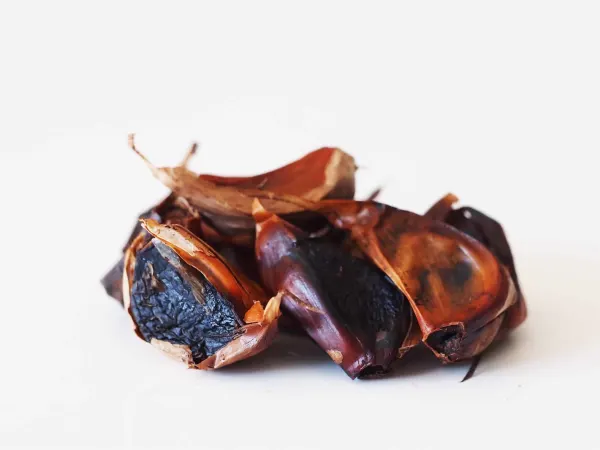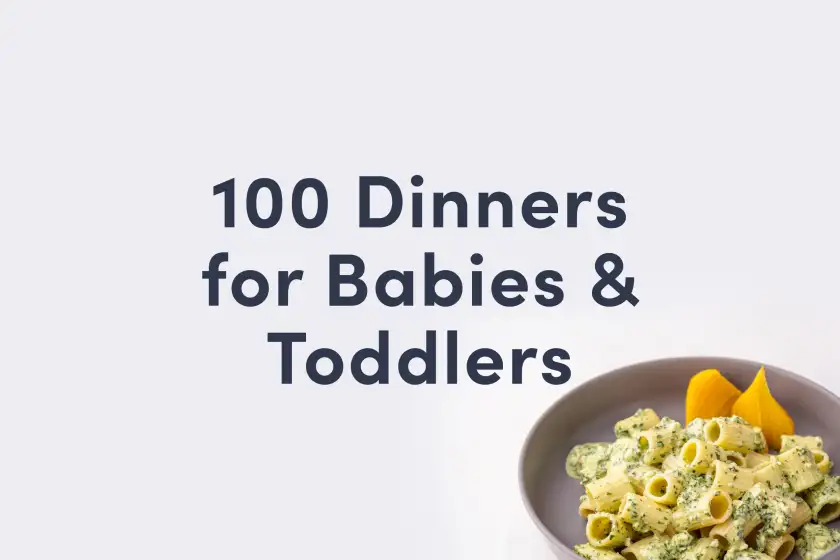Black Garlic
Vegetable
Age Suggestion
6 months
Iron-Rich
No
Common Allergen
No

What is black garlic?
Black garlic is fresh garlic that has been fermented, which creates a soft texture and sweet flavor that is far less pungent than raw garlic.
Fermented garlic is made by storing raw garlic cloves at low temperatures in a humidity-controlled environment for an extended period of time. The fermentation process breaks down the enzymes behind raw garlic’s assertiveness and produces the Maillard reaction—the same chemical activity that creates that deep flavor in seared hamburgers, roasted chicken skin, and fried onions. Black garlic has been a traditional cooking ingredient for centuries in Asia, and only recently has become a trend in the Americas and Europe.
When can babies eat black garlic?
Garlic (including black garlic) may be introduced as soon as your baby is ready to start solids, which is typically around 6 months of age.
Background and origins of black garlic
Garlic is native to Central Asia, where it has long been used for a variety of medicinal purposes—from improving respiration to alleviating diarrhea. Many people believe that bland foods are best for babies, but there is no evidence to support this cultural myth. In fact, people around the world introduce alliums and other flavorful foods to babies who are ready to start solids. One study even found that babies nurse longer and ingest more breast milk from mothers who have ingested garlic.
Garlic is an allium—the plant family that includes chives, leek, onions, and shallots. In cooking, most recipes calling for “garlic” are referring to the white cloves that make up a raw bulb, however black garlic cloves are an easy substitute, especially for babies. The fermentation process to create black garlic not only yields a more mild flavor, but also lends probiotic benefits that support digestion, immunity, and a healthy gut microbiome.
Videos
Is black garlic healthy for babies?
Absolutely. Garlic is packed with nutrients that are critical for babies at this stage in their development, including vitamins B6 and C, calcium, copper (which helps your baby absorb for iron), manganese, phosphorus, and selenium. Compared with raw garlic, black garlic is lower in vitamin C but higher in fiber and iron. The fermentation process to produce black garlic also increases the bioavailability of its nutrients, meaning a greater proportion of garlic’s nutritional content is absorbed and utilized by the body upon eating black garlic. For example, black garlic offers greater antioxidant content for the body, which helps protect a baby from harmful environmental toxins and as noted above, offers probiotic benefits that support digestion, immunity, and a healthy gut microbiome.
When not stored properly, certain preparations of garlic can increase the risk of botulism. While fresh garlic stored in oil poses the greater risk, black garlic in oil can also cause illness. To reduce the risk, try to avoid preparations of black garlic stored in oil and, as usual, follow the storage instructions and expiration date on packages of black garlic. Read more about how to safely store garlic here.
Is black garlic a common choking hazard for babies?
It can be. While not listed as a common choking hazard, black garlic cloves can absolutely pose a risk if not prepared in an age-appropriate way for your baby. Black garlic is also stickier than raw garlic, so be sure to mince or mash before mixing it with food for babies who are starting solids. Even then, stay near your baby and watch closely during mealtimes.
For more information, visit our section on gagging and choking and familiarize yourself with common choking hazards.
Is black garlic a common allergen?
No. Garlic allergy is rare, though there are cases of people with allergies to foods in the allium family. If you have a family history of allergies or suspect your baby may be allergic to onions, make an appointment with an allergist before introducing garlic.
How do you prepare black garlic for babies with baby-led weaning?
Every baby develops on their own timeline, and the suggestions on how to cut or prepare particular foods are generalizations for a broad audience.
6 to 12 months old:
Mash black garlic with a fork and sauté in a skillet with a splash of olive oil, then mix the flavored oil into a vegetable dish such as mashed sweet potatoes, a bowl of grains like quinoa or rice, or an omelet.
12 to 24 months old:
Try your hand at black garlic bread. And don’t hold back: use garlic (fresh or fermented) liberally in your dishes. The options are endless: in marinades and salad dressings, mixed with roasted or steamed vegetables, roasted and spread on whole grain bread, or sautéed in butter for a simple pasta sauce.
Packages of black garlic can be stored at room temperature, but once opened, they must be stored in the refrigerator, where they will last for approximately one month.
Fresh, raw, or fermented garlic served plain can be challenging for even for adults to digest, so try mixing a small amount into another dish when introducing black garlic to your baby.
For more information on how to cut food for babies, visit our page on Food Sizes & Shapes.
Written and reviewed by these specialists
Expert Tips Delivered to Your Inbox
Sign up for weekly tips, recipes and more!
The content offered on SolidStarts.com is for informational purposes only. Solidstarts is not engaged in rendering professional advice, whether medical or otherwise, to individual users or their children or families. No content on this site, regardless of date, should ever be used as a substitute for direct medical advice from your doctor or your medical or health professional, nutritionist, or expert in pediatric feeding and eating. By accessing the content on SolidStarts.com, you acknowledge and agree that you are accepting the responsibility for your child’s health and well-being. In return for providing you with an array of content “baby-led weaning” information, you waive any claims that you or your child may have as a result of utilizing the content on SolidStarts.com.







